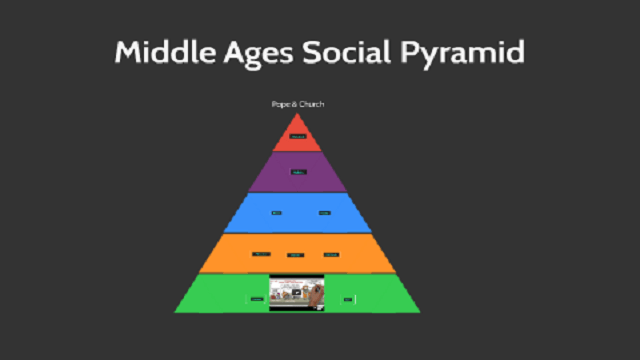What is the Social Pyramid of the Middle Ages?
The social pyramid of the Middle Ages is the graphic representation that shows how society was structured between the 5th and 15th centuries, based on the decision-making power of the different social classes.
Key points
- Medieval society was organized in a pyramid where power was concentrated at the top.
- Social mobility was extremely limited; people were born and died in the same class.
- The king was the central figure to whom all estates owed loyalty and obedience.
Social pyramid of the Middle Ages: Simple explanation
In other words, the social pyramid of the Middle Ages shows how medieval society was organized based on power and social position.
This hierarchical structure determined the functions, rights, and duties of each group. It served to maintain social order and ensure that each person knew their place and responsibilities.
In practical terms, this hierarchical organization could help you understand how power relations worked and how resources and privileges were distributed in medieval society.
Estates in the Middle Ages
As far as the social classes in the Middle Ages are concerned, we must know that there were mainly 6 classes.
These are the following:
- King: They had the power, along with the clergy.
- High clergy and high nobility: Together with the kings, they had power and controlled the population through religion. It was made up of bishops and high-ranking officials of the Church, as well as generals and high-ranking officials of the army, as well as advisors to the king.
- Lower clergy and lower nobility: These were the illustrious knights who accompanied the king, as well as people trusted by the governors and who had privileges due to their status. Also the more modest positions in the Church, such as parish priests, etc.
- Bourgeoisie and army: This was a social class that, although it did not have the same privileges as its predecessors, did have a more privileged status. Likewise, the knights in charge of going into battle were in this same status. For this reason, the king recognized them with a more privileged status. Sometimes, these knights, for their exploits in combat, obtained the privilege of rising in social class.
- Free people: They were the lowest social stratum, along with the serfs. They did not have many privileges. They had to pay a portion of their earnings to the king.
- Serfs: They were slaves. They had no rights. Nor did they earn any profits. The marginalized and the beggars were also found in this stratum.
Characteristics of a Social Pyramid of the Middle Ages
Among the characteristics of a social pyramid in the Middle Ages, we can highlight the following:
- It presents the social structure of a population between the 5th and 15th centuries.
- They were class societies.
- The order of ranking is descending. That is, the one with the most power is at the top and the one with the least power is at the bottom.
- The systems were closed. That is, you were born in the class in which you died.
- The right to belong to a certain class could only be acquired through birth, or sometimes as recognition for some reason.
- They allowed their allegiance to the king.

